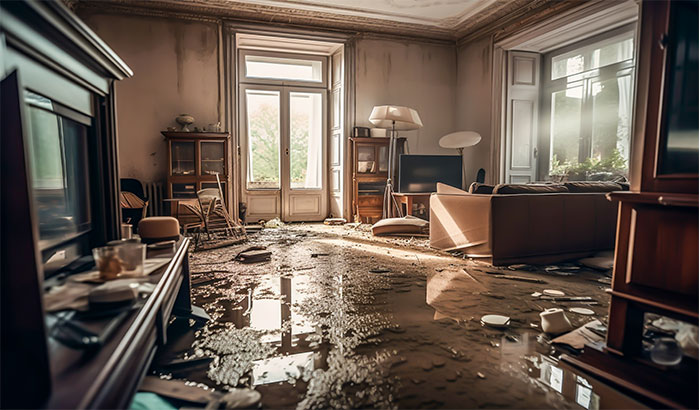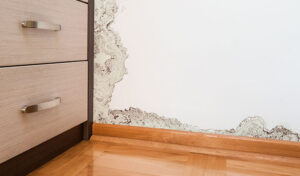As a homeowner, understanding the risks associated with water damage is crucial in safeguarding your property and ensuring its longevity.
Water damage can wreak havoc on various areas of your home, leading to costly repairs, structural issues, and potential health hazards. By being aware of the common causes and vulnerable areas, you can take proactive steps to prevent water damage and preserve the integrity of your home.
In this blog, we’ll explore eight areas in your home that are more susceptible to water damage. From the often-neglected attic to the frequently used bathrooms and kitchens, we’ll provide expert insights and practical tips to help you fortify these vulnerable spaces.
8 Areas Prone to Water Damage
Water damage can occur almost anywhere, but some places are more vulnerable. By understanding the unique challenges in each of these areas and implementing preventive measures, you can fortify your home against the relentless forces of water damage.
Let’s get started.
1. Attic
Hidden beneath your roof, the attic is often an overlooked space when it comes to regular maintenance and protection against water damage. However, the attic is highly susceptible to water intrusion, so paying attention to its condition is crucial.
Leaks and moisture buildup in the attic can lead to mold growth, compromised insulation, and structural damage.
Firstly, inspect your attic for any signs of leaks or water entry points. Check for dark stains, discoloration, or dampness on the ceiling or walls. These could indicate an ongoing or past water intrusion issue.
Additionally, look for water stains or rot on wooden components such as rafters and trusses. Identifying these signs early on can help you take prompt action to address the source of the problem.
One of the primary causes of attic water damage is a compromised roof. Inspect the condition of your roof regularly, looking for damaged or missing shingles, deteriorated flashing, or clogged gutters. These issues can allow rainwater to seep into your attic. Promptly address any roof-related problems by repairing or replacing damaged components, ensuring a watertight seal.
Proper insulation and ventilation are also vital for preventing moisture buildup in the attic. Inadequate insulation can lead to condensation, which, over time, can cause water damage.
Ensure your attic has sufficient insulation, preventing warm, moist air from escaping into the attic space. Additionally, proper ventilation allows for air circulation, reducing the chances of condensation and mold growth. Install vents and fans to promote adequate airflow in the attic.
2. Bathroom
The bathroom, a space synonymous with water, is naturally prone to water damage if not properly maintained and protected. From daily activities like showers and baths to plumbing fixtures that are constantly in use, the bathroom presents unique challenges when preventing water damage.
You should regularly inspect the bathroom for any signs of leaks. Check around the toilet base, sink, and shower areas for water stains, soft spots on the floor, or dripping water. These could indicate underlying plumbing issues that need immediate attention.
Promptly repair any leaks or dripping faucets to prevent water from seeping into the walls or flooring, causing damage over time. You should also make sure that your bathroom is sealed correctly. Check the caulk and grout around the bathtub, shower, and sink.
If you notice any cracks or gaps, reapply caulk or grout to maintain a watertight seal. This will prevent water from penetrating into vulnerable areas and causing water damage on hardwood floors, baseboards, doors, or anything else in the bathroom.
Proper ventilation is crucial in the bathroom to prevent excessive moisture buildup. Run the bathroom exhaust fan during and after showers to reduce humidity levels and promote airflow. Moisture and mold that accumulates in the bathroom can lead to mold on carpet of adjacent rooms and deteriorate surfaces.
3. Kitchen
The kitchen, the bustling heart of any home, is no stranger to water-related mishaps and potential water damage. From cooking activities to the operation of various appliances, the kitchen requires extra attention to minimize the risk of water-related issues.
You should regularly inspect the kitchen sink and its surrounding area for any leaks or drips. Check the faucet, drain connections, and supply lines for any signs of water accumulation or moisture. Promptly repair any leaks to prevent water from seeping into cabinets or flooring, which can lead to costly damage.
It’s also important to pay attention to the condition of the dishwasher. Inspect the supply lines and connections, ensuring they are secure and free from leaks.
Periodically check the dishwasher for any signs of water accumulation, which may indicate a malfunction or a leak in the appliance. Promptly address any issues to prevent water damage to nearby cabinetry and flooring.
4. Laundry Room
The laundry room is another obvious location prone to water damage. The last thing you want is for your washing machine to malfunction and spray water all over.
Regularly inspect the hoses and connections of your washing machine. Look for signs of wear, cracks, or leaks. Replace old or damaged hoses with high-quality, reinforced ones to reduce the risk of leaks and water damage.
You should also make sure that the laundry room has proper drainage. Check that the floor drain is clear and functioning effectively.
5. Basements
Basements are notorious for being vulnerable to water damage, as they are below ground level and prone to moisture intrusion.
Inspect the foundation walls for cracks or gaps that may allow water to seep in. Seal any visible cracks with an appropriate waterproofing sealant. Addressing foundation issues promptly can prevent water infiltration and potential structural damage.
Ensuring proper drainage around the perimeter of your home is also super important. Keep gutters and downspouts clear of debris to direct rainwater away from the foundation. Consider extending downspouts or installing downspout extensions to carry water further away from the house. Proper grading around the foundation can also aid in diverting water away from the basement.
You should also make sure you have a sump pump installed in your basement. A sump pump can help prevent water accumulation during heavy rainstorms or in areas with high groundwater levels. Regularly check that the sump pump is in proper working condition and consider installing a battery backup system to ensure functionality during power outages.
6. In the Walls
Water damage that occurs within the walls can be particularly challenging to detect and address. Leaking pipes, faulty plumbing connections, or roof leaks can result in hidden moisture buildup, leading to mold growth, weakened structural integrity, and damage to insulation.
Regularly monitor your water bill for any unexpected increases, as it could indicate a hidden plumbing leak within the walls. Look out for water stains, discoloration, or bubbling paint on the walls, as these can be signs of water damage. If you suspect water damage in the walls, it’s crucial to consult a professional for a thorough inspection and necessary repairs.
7. Ceiling
Water damage in ceilings can be a telltale sign of an underlying issue that requires immediate attention. Leaks from above, such as a roof leak, plumbing problem, or bathroom water overflow, can result in unsightly stains, sagging or bulging ceilings, and even potential structural damage.
If you notice water stains, discoloration, or peeling paint on your ceiling, it’s essential to identify and address the source of the water promptly. Inspect the area above the affected ceiling for any visible signs of leaks or plumbing issues.
8. Windows
While windows are designed to provide natural light and ventilation, they can also be potential entry points for water if not properly maintained. Leaking windows can lead to water damage, rotting frames, and compromised insulation.
Regularly inspect your windows for any signs of leaks or water intrusion. Look for water stains, peeling paint, or warped frames, which may indicate a problem. Check the seals and caulking around the window frames and ensure they are intact and in good condition, and replace any damaged or deteriorated seals as soon as possible.
Your Home Has Experienced Water Damage; What Do You Do?
When faced with water damage in your home, it’s crucial to seek professional assistance from a reputable water damage restoration and cleanup company. These experts have the knowledge, experience, and specialized equipment to effectively assess the extent of the damage, extract water, dry the affected areas, and restore your home to its pre-damaged condition.
They are equipped to handle the complexities of water damage, including issues such as water damage on hardwood floors. By calling a water damage restoration and cleanup company, you ensure that the necessary treatments and techniques are applied to prevent further deterioration.
Their expertise in water damage cleanup and restoration saves you time and effort and helps minimize the long-term effects of water damage, such as mold on carpet and other surfaces.
Don’t hesitate to reach out to a professional service to handle the water damage restoration and cleanup, allowing you to focus on the well-being of your family and restoring your home to its former state.
Have Water Damage? Let Total Flood and Fire Restoration Help!
When water damage wreaks havoc in your home, Total Flood and Fire Restoration is the name you can trust to handle the cleanup and restoration with expertise and precision. Our dedicated team specializes in water damage restoration, including addressing issues like water damage on hardwood floors/baseboards and mold on carpet.
With our extensive experience and advanced techniques, we understand the urgency of water damage situations. That’s why we offer prompt response times and 24/7 emergency services. When you contact Total Flood and Fire Restoration, our skilled technicians will swiftly assess the damage and develop a personalized plan to restore your home.
Our comprehensive water damage cleanup and restoration services include efficient water extraction, thorough structural drying, mold remediation, and necessary repairs. We utilize state-of-the-art equipment and industry-leading methods to ensure the highest quality restoration.
At Total Flood and Fire Restoration, we prioritize your satisfaction and peace of mind. We work closely with you throughout the restoration process, providing clear communication and transparent updates. Our goal is to minimize disruption to your life and deliver exceptional results.
Don’t let water damage control your home and well-being. Contact Total Flood and Fire Restoration today by calling us at 385-483-2109 for expert water damage cleanup and restoration services.







